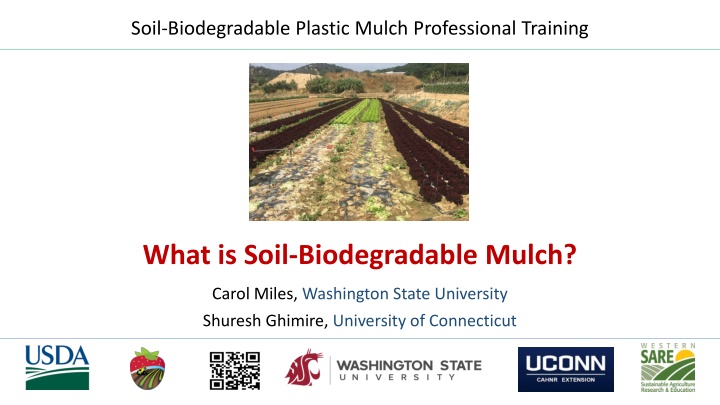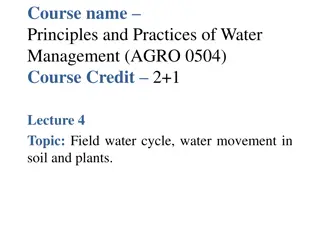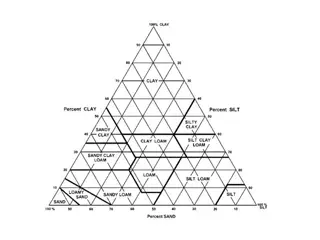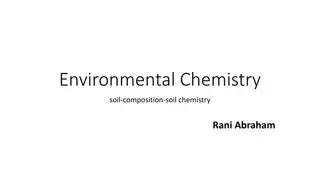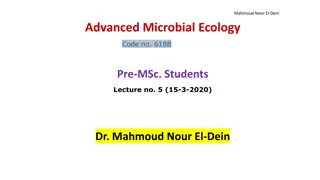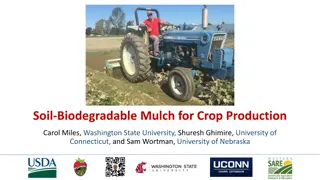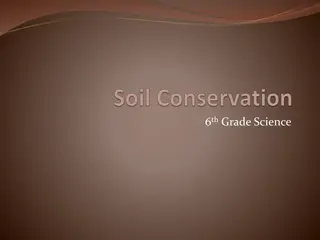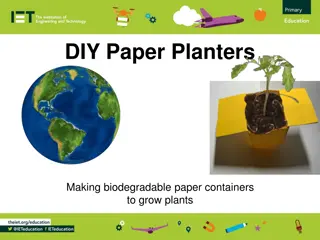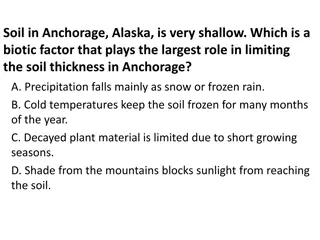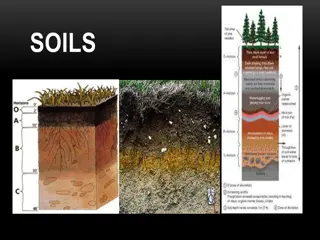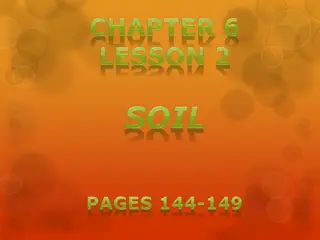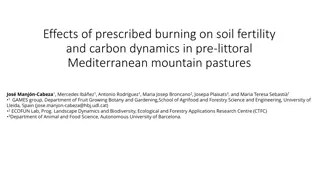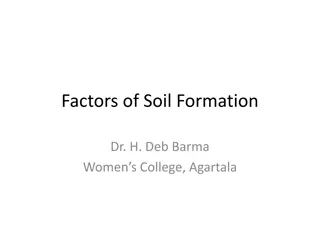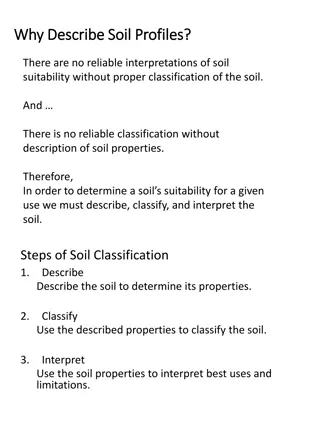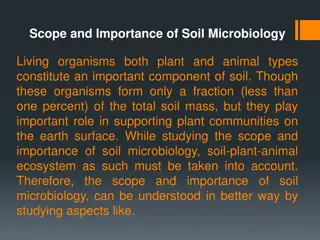What is Soil-Biodegradable Mulch?
Soil-biodegradable mulch (BDM) serves as a sustainable alternative to polyethylene mulch, offering weed control, moisture retention, soil temperature modification, early harvest, increased crop yield, and quality. It can be tilled into the soil after use, reducing waste and disposal challenges. Learn about the introduction of BDM, feedstocks used in its production, and considerations related to biobased content and biodegradation.
Download Presentation

Please find below an Image/Link to download the presentation.
The content on the website is provided AS IS for your information and personal use only. It may not be sold, licensed, or shared on other websites without obtaining consent from the author.If you encounter any issues during the download, it is possible that the publisher has removed the file from their server.
You are allowed to download the files provided on this website for personal or commercial use, subject to the condition that they are used lawfully. All files are the property of their respective owners.
The content on the website is provided AS IS for your information and personal use only. It may not be sold, licensed, or shared on other websites without obtaining consent from the author.
E N D
Presentation Transcript
Soil-Biodegradable Plastic Mulch Professional Training What is Soil-Biodegradable Mulch? Carol Miles, Washington State University Shuresh Ghimire, University of Connecticut
Alternative to PE Mulch Soil-biodegradable mulch (BDM) can be a sustainable alternative to polyethylene (PE) mulch: Provides crop production benefits comparable to PE mulch: Weed control Moisture retention Soil temperature modification Early harvest Increase crop yield and quality Designed to be tilled into the soil after use, eliminating waste and disposal challenges Note: BDMs should not go into recycling facilities, they will contaminate recyclate
Introduction of BDM 1990 German government published call for research and development of biodegradable thermoplastics 1991 Novamont introduced Mater-Bi line 1996 Bayer BAK introduction line extrusion and injection molding grades 2009 First USDA SCBG to investigate BDMs 2014 BASF / Organix Solution BDM
BDM Feedstocks Plastic BDMs made from feedstocks that are biobased, derived from fossil fuels, or a blend of the two Biobased polymers divided into three categories: Extracted from natural materials Produced by chemical synthesis Produced by microorganisms starch, thermoplastic starch (TPS), and cellulose synthetic polymerization of lactic acid into polylactic acid (PLA) polyhydroxyalkanoates (PHA) TPS processed from high- amylose starch, cheaper than other starch feedstocks PLA produced relatively inexpensively compared to other biobased biopolymers Poly(hydroxybutyrate) (PHB) and poly(hydroxyvalerate) (PHV) most important commercial PHAs
Feedstock Considerations Percent biobased content not an indicator of biodegradation: PLA requires high temperature for biodegradation Manufacturing plastic mulch (including BDMs) involves the addition of plasticizers, fillers (e.g., CaCO3), lubricants, nucleating agents, stabilizers and colorants/dyes The additives used in commercial plastic BDMs may or may not be produced from GMOs Most commercially available PLA and PHA are produced through fermentation using GM yeast and bacteria for increased productivity Biobased mulches are not tested for the presence of GMOs: DNA degraded following fermentation and processing and not discernable using tests
Standards for Biodegradation Intended to ensure BDM quality and integrity in agriculture Intended to exclude materials that are claimed to be biodegradable but are not fully mineralized by microbes, which results in plastic residues in soils, causing pollution Composting standards serve as the first critical test of biodegradability, if BDM is not compostable, it will likely not biodegrade under field conditions Standards do not guarantee a particular degree of performance in the field, as this depends on production system (crop, climate, soils, etc.), mulch formulation and thickness, and farming practices
BDM Standards Standard Organization Standard Name Comments First international standard directly pertaining to BDMs by an international organization. Includes specifications for both biodegradable material/feedstock and biodegradable mulch product such as dimensional, mechanical and optical properties, ecotoxicity, and biodegradation. EN 17033 (2018) Plastics Biodegradable Mulch Films for Use in Agriculture and Horticulture Requirements and Test Methods European Committee for Standardization (CEN) UNI 11495 (2013) Biodegradable Thermoplastic Materials for Use in Agriculture and Horticulture - Mulching Films - Requirements and Test Methods Ente Nazionale Italiano di Unificazione (UNI) Italian standard pertaining to BDMs ASTM D6400 (2012) Standard Specification for Labeling of Plastics Designed to be Aerobically Composted in Municipal or Industrial Facilities Pertains directly to biodegradation under industrial composting conditions, and is often misrepresented1 ASTM, International Certifies that plastic materials will biodegrade fully and will not promote ecotoxicity in the soil TUV Austria (formerly Vincotte)2 OK Biodegradable SOIL (label) 1 ISO (International Organization for Standardization) has equivalent standards 2TUV Austria is not a standards organization but is a certification body authorized by European Bioplastics, an association representing the interest of the European bioplastics industry. Source: Dentzman and Hayes (2019)
BDM Standards ASTM D6400 tests biodegradation under industrial composting conditions (2012) Most commonly cited standard for BDM Employs standardized test method ASTM D5338 to establish inherent biodegradation: o Laboratory test that simulates industrial composting conditions: use of a compost-based medium, 58 , etc. 90% conversion of C into CO2 and microbial biomass within 180 days EN 17033 European Committee for Standardization (CEN) (Jan. 2018) 1st standard for certification of biodegradable plastic mulch films in soil Requirements regulated: composition; biodegradability in soil; ecotoxicity, dimensional, mechanical and optical properties; and the test procedures for each 90% biodegradation under aerobic conditions in natural topsoil from agricultural field or forest at 20 to 28 C within 2 years using standardized test to measure CO2 evolution Why 90% biodegradation and not 100%: Difficult to measure portion of the plastic-derived C incorporated into microbial biomass Limited precision of the biodegradability lab tests
Oxo- and Photo-degradable Oxo and photo-degradable plastic made with conventional plastic: HDPE, LDPE, PP, PS, PET or PVC Includes additives that cause the material to become brittle and break apart into fragments when exposed to UV light, heat and/or oxygen EU to prohibit single-use plastic products and products made from oxo-degradable plastic (European Parliament Directive 2019/904 Article 5, passed 5 June 2019 to take effect July 2021)
Resources The Role of Standards for Use of Biodegradable Plastic Mulches: Truths and Myths https://ag.tennessee.edu/biodegradablemulch/Documents/Standards%20Factsheet%20Formatted%2 0revised%2015Jan2019.pdf Summary and Assessment of EN 17033:2018, a New Standard for Biodegradable Plastic Mulch Films https://ag.tennessee.edu/biodegradablemulch/Documents/EU%20regs%20factsheet.pdf Oxo-degradable Plastics Risk Environmental Pollution https://ag.tennessee.edu/biodegradablemulch/Documents/oxo%20plastics.pdf Biodegradable Plastic Mulch and Suitability for Sustainable and Organic Agriculture http://pubs.cahnrs.wsu.edu/publications/pubs/fs103e/ Video: Biodegradable Mulch Breakdown in Soil: Role of Microbiology: https://www.youtube.com/embed/-EqrF2y9lh0
